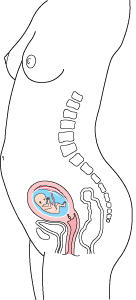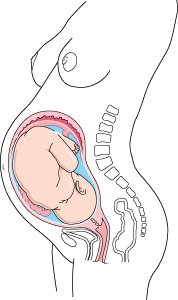Stages of pregnancy
- First trimester (week 1-week 12)
- Second trimester (week 13-week 28)
- Third trimester (week 29-week 40)
- Your developing baby
- More information on stages of pregnancy
Pregnancy lasts about 40 weeks, counting from the first day of your last normal period. The weeks are grouped into three trimesters (TREYE-mess-turs). Find out what's happening with you and your baby in these three stages.
First trimester (week 1-week 12)
For some women, body image is a huge concern during pregnancy. Learn what you can do to accept and love your pregnant body in our Pregnancy and body image section.
During the first trimester your body undergoes many changes. Hormonal changes affect almost every organ system in your body. These changes can trigger symptoms even in the very first weeks of pregnancy. Your period stopping is a clear sign that you are pregnant. Other changes may include:
- Extreme tiredness
- Tender, swollen breasts. Your nipples might also stick out.
- Upset stomach with or without throwing up (morning sickness)
- Cravings or distaste for certain foods
- Mood swings
- Constipation (trouble having bowel movements)
- Need to pass urine more often
- Headache
- Heartburn
- Weight gain or loss
As your body changes, you might need to make changes to your daily routine, such as going to bed earlier or eating frequent, small meals. Fortunately, most of these discomforts will go away as your pregnancy progresses. And some women might not feel any discomfort at all! If you have been pregnant before, you might feel differently this time around. Just as each woman is different, so is each pregnancy.
Second trimester (week 13-week 28)
Most women find the second trimester of pregnancy easier than the first. But it is just as important to stay informed about your pregnancy during these months.
You might notice that symptoms like nausea and fatigue are going away. But other new, more noticeable changes to your body are now happening. Your abdomen will expand as the baby continues to grow. And before this trimester is over, you will feel your baby beginning to move!
As your body changes to make room for your growing baby, you may have:
- Body aches, such as back, abdomen, groin, or thigh pain
- Stretch marks on your abdomen, breasts, thighs, or buttocks
- Darkening of the skin around your nipples
- A line on the skin running from belly button to pubic hairline
- Patches of darker skin, usually over the cheeks, forehead, nose, or upper lip. Patches often match on both sides of the face. This is sometimes called the mask of pregnancy.
- Numb or tingling hands, called carpal tunnel syndrome
- Itching on the abdomen, palms, and soles of the feet. (Call your doctor if you have nausea, loss of appetite, vomiting, jaundice or fatigue combined with itching. These can be signs of a serious liver problem.)
- Swelling of the ankles, fingers, and face. (If you notice any sudden or extreme swelling or if you gain a lot of weight really quickly, call your doctor right away. This could be a sign of preeclampsia.)
Third trimester (week 29-week 40)
You're in the home stretch! Some of the same discomforts you had in your second trimester will continue. Plus, many women find breathing difficult and notice they have to go to the bathroom even more often. This is because the baby is getting bigger and it is putting more pressure on your organs. Don't worry, your baby is fine and these problems will lessen once you give birth.
Some new body changes you might notice in the third trimester include:
- Shortness of breath
- Heartburn
- Swelling of the ankles, fingers, and face. (If you notice any sudden or extreme swelling or if you gain a lot of weight really quickly, call your doctor right away. This could be a sign of preeclampsia.)
- Hemorrhoids
- Tender breasts, which may leak a watery pre-milk called colostrum (kuh-LOSS-struhm)
- Your belly button may stick out
- Trouble sleeping
- The baby "dropping", or moving lower in your abdomen
- Contractions, which can be a sign of real or false labor
As you near your due date, your cervix becomes thinner and softer (called effacing). This is a normal, natural process that helps the birth canal (vagina) to open during the birthing process. Your doctor will check your progress with a vaginal exam as you near your due date. Get excited — the final countdown has begun!
Your developing baby
First trimester (week 1-week 12)
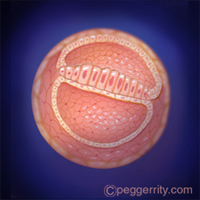 |
At four weeks:
|
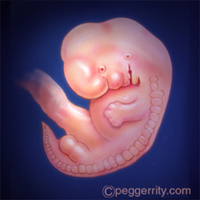 |
At eight weeks:
|
 |
At 12 weeks:
|
Second trimester (week 13-week 28)
 |
At 16 weeks:
|
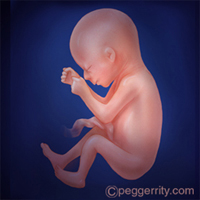 |
At 20 weeks:
|
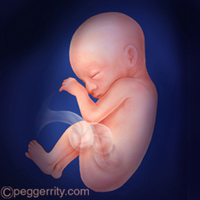 |
At 24 weeks:
|
Third trimester (week 29-week 40)
 |
At 32 weeks:
|
 |
At 36 weeks:
|
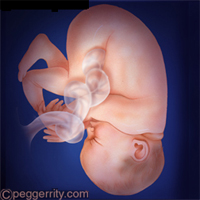 |
Weeks 37-40:
|
More information on stages of pregnancy
Explore other publications and websites
-
First Trimester Pregnancy: What to Expect (Copyright © Mayo Foundation) — This fact sheet discusses the physical changes and symptoms experienced in the first three months of pregnancy.
http://www.mayoclinic.com/health/pregnancy/PR00004
-
How Your Baby Grows (Copyright © March of Dimes) — This site provides information on the development of your baby and the changes in your body during each month of pregnancy. In addition, for each month, it provides information on when to go for prenatal care appointments and general tips to take care of yourself and your baby.
http://www.marchofdimes.com/pnhec/28699_2134.asp
-
Morning Sickness (Copyright © American Academy of Family Physicians) — This publication discusses morning sickness, how long it will last, and how to help relieve the symptoms.
http://familydoctor.org/online/famdocen/home/women/pregnancy/basics/154.html
-
Pregnancy Calendar: A Week-by-Week Guide (Copyright © Nemours Foundation) — This illustrated pregnancy calendar is a detailed guide to all the changes taking place in your baby — and in you! Each week of pregnancy includes a description of your baby's development, as well as an explanation of the changes taking place in your body. You'll also find important medical information that will help keep you and your baby healthy.
http://www.kidshealth.org/parent/pregnancy_newborn/calendar/pregnancy_calendar_intro.html
-
Second Trimester Pregnancy: What to Expect (Copyright © Mayo Foundation) — This fact sheet discusses how the changes that began in the first weeks of pregnancy increase and accelerate during the second trimester. Of these, your growing uterus is probably the most obvious. But many other, unseen events are also taking place.
http://www.mayoclinic.com/print/pregnancy/PR00018/METHOD=print
-
Taking Care of You and Your Baby While You're Pregnant (Copyright © American Academy of Family Physicians) — This publication discusses the importance of prenatal care, what happens during doctor visits, how much weight should be gained during pregnancy, what you should eat, and also a list of dos and don’ts during pregnancy.
http://familydoctor.org/online/famdocen/home/women/pregnancy/basics/053.html
-
Third Trimester Pregnancy: What to Expect (Copyright © Mayo Foundation) — This fact sheet explains how at term or the third trimester, the uterus will weigh about 2 1/2 pounds and will have stretched to hold your baby, the placenta, and about a quart of amniotic fluid. Nearly all of the physical symptoms of late pregnancy arise from this increase in the size of the uterus.
http://www.mayoclinic.com/print/pregnancy/PR00009/METHOD=print
-
Weight Gain During Pregnancy (Copyright © March of Dimes) — This brief fact sheet explains how much weight a woman should gain during pregnancy by explaining the different aspects of pregnancy that add to overall weight.
http://www.marchofdimes.com/printableArticles/159_153.asp
Connect with other organizations
-
American Academy of Family Physicians
http://familydoctor.org/online/famdocen/home.html
-
American College of Obstetricians and Gynecologists
http://www.acog.org/
-
American Pregnancy Association
http://www.americanpregnancy.org/
-
KidsHealth
http://kidshealth.org/
-
March of Dimes
http://www.marchofdimes.com
Content last updated September 27, 2010.
Resources last updated September 27, 2010.
womenshealth.gov
A federal government website managed by the Office on Women's Health in the Office of the Assistant Secretary for Health at the U.S. Department of Health and Human Services.
200 Independence Avenue, S.W. • Washington, DC 20201


 Text size
Text size Email
Email